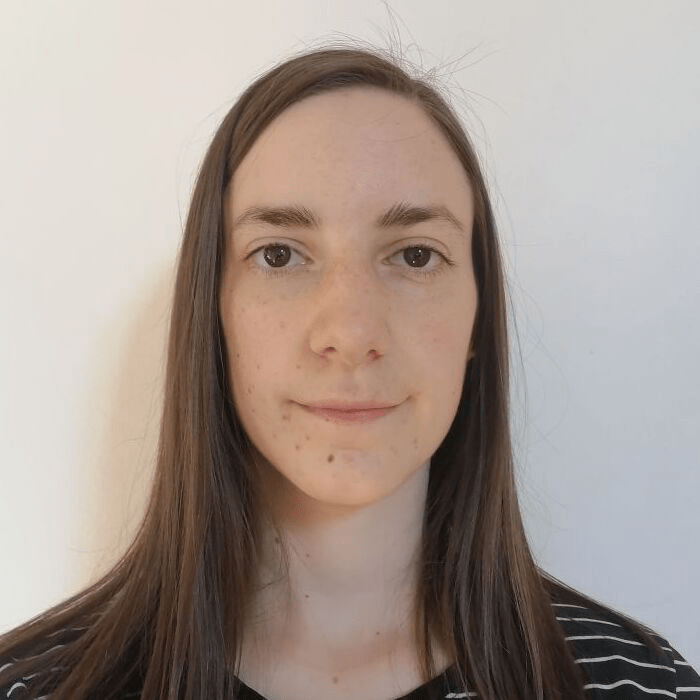Do you ever feel like all the talking you’re doing at work isn’t getting you any closer to reaching an understanding with your employees, peers, and higher-ups?
Maybe you should take that as a sign to stop talking and start connecting, instead.
One way to do so would be to focus on hearing other people out by using the skill of active listening.
Then again, that’s only one side of the communication coin. If you really want to become a more effective communicator, you should also make a point of practicing active communication in the workplace.
But, what is active communication and can it be effectively utilized even in a remote workplace? That’s what we’re about to find out.

- Active communication is a highly-involved communication technique that requires participants to practice clear expression while also actively listening to others — with the goal of ensuring mutual understanding.
- The process of active communication can be divided into 3 stages: active communication through clear encoding, active listening or thoughtful decoding, and closing the loop through feedback and clarification.
- In the era of instant messaging apps, active communication can be practiced in video calls, but it also translates well to asynchronous, written communication.
- Team communication apps like Pumble can help us practice active communication in the digital age by allowing us to mindfully communicate while also giving us time to thoughtfully process and respond to other people’s messages.
Table of Contents
The active communication loop: A 3-step framework for achieving mutual understanding and clarity
Active communication is a highly-involved two-way communication technique that requires participants to practice clear and thoughtful expression while engaging in deep listening, with the goal of ensuring mutual understanding.
Unlike typical workplace communication, which is exemplified by merely informative one-sided reports, active communication requires — you guessed it — active participation from all parties involved.
That means that everyone needs to set their egos aside and make a concerted effort to reach an understanding.
Generally speaking, there are 3 stages to reaching this desired result:
- Clear encoding of the message, i.e. mindfully expressing your thoughts and ideas,
- Thoughtful decoding of the message, i.e. paying attention to what others are saying or feeling, and
- Feedback and clarification, i.e. making sure everyone is on the same page by the end of the exchange.
However, participants often cycle through all of these stages or even go through them simultaneously during an instance of active communication.
In any case, this communication technique is typically employed in the interest of reaching a decision or solving a problem faster, and has the added benefit of:
- Building trust in the workplace,
- Breaking down team silos,
- Preventing miscommunication, and
- Overcoming various other communication challenges.
Experience effective team communication with Pumble
Active communication vs passive communication
At this point, we should acknowledge that some people might compare active communication to passive communication.
However, while active communication is a technique for ensuring understanding, passive communication is one of several styles of communication, along with the aggressive, passive-aggressive, manipulative, and assertive styles.
Of those, assertive communication is actually the most complementary style for engaging in active communication, as shown in the table below.
| ACTIVE COMMUNICATION | PASSIVE COMMUNICATION |
|---|---|
| — Assertiveness and self-awareness — Direct expression — Openly addressing issues, problem solving — Collaboration and relationship building — Active listening | — Passivity/meekness — Indirect expression — Conflict avoidance, accepts a lack of clarity — Suppressed feelings, resentment — Passive listening |
In practice, passive communicators tend to avoid addressing issues and hold onto resentment despite that lack of acknowledgement.
Conversely, active communicators tend to:
- Actively seek, use, and share knowledge,
- Maintain positive relationships with coworkers, clients, and partners,
- Proactively search for information on company values and strategies,
- Negotiate with the purpose of achieving mutual understanding,
- Engage in informal diagonal communication and cross-functional collaboration,
- Inform management about potential or existing problems, and
- Protect and enhance the company’s reputation.
So, what’s the first step to achieving this kind of engagement in the workplace?
Well, as with any organizational change, it has to start from the top — with leaders learning how to communicate more transparently.
Part 1: The art of active speaking (clear encoding)
Having discussed the differences between active and passive communication, it’s time to break down the individual stages of the active communication process.
As we have established, thoughtful encoding of messages is the crucial first stage of active communication in the workplace, requiring you to:
- State your intent first,
- Be clear and concise,
- Keep your body language in check,
- Know your audience,
- Invite questions, and
- Provide next steps.
However, we should note that none of these steps require verbal communication, specifically. As proof, we’ll illustrate our tips by providing examples of active communication as they might occur on a team communication app like Pumble by CAKE.com.
Tip #1: State your intent first
If you want to get better at active communication, you should practice frontloading your messages to ensure that your intent is clear.
That means that you’ll want to explain what your message is about right away, whether you’re looking to:
- Assign a task,
- Ask for help, or
- Give constructive feedback.
If you want people to understand exactly what’s being asked of them and by whom, you might want to avoid the passive voice and stick to making “I” statements.
For example, the following message does a poor job of revealing intent: “Hey, the new project is coming up. It would be good if you could take the lead.”
That message doesn’t let the other person know when the new project will start or who wants them to take the lead on it (or why). You could make your intent more clear by adding more detail, as shown below:
“Hey, looks like the new project will start in about 2 weeks. I’d like for you to take the lead on that, since it could lead to other opportunities down the line, and I know you’ve been looking to take on more responsibility.”
Having said that, here’s another example of active communication that makes intent clear and communicates expectations from the get-go.
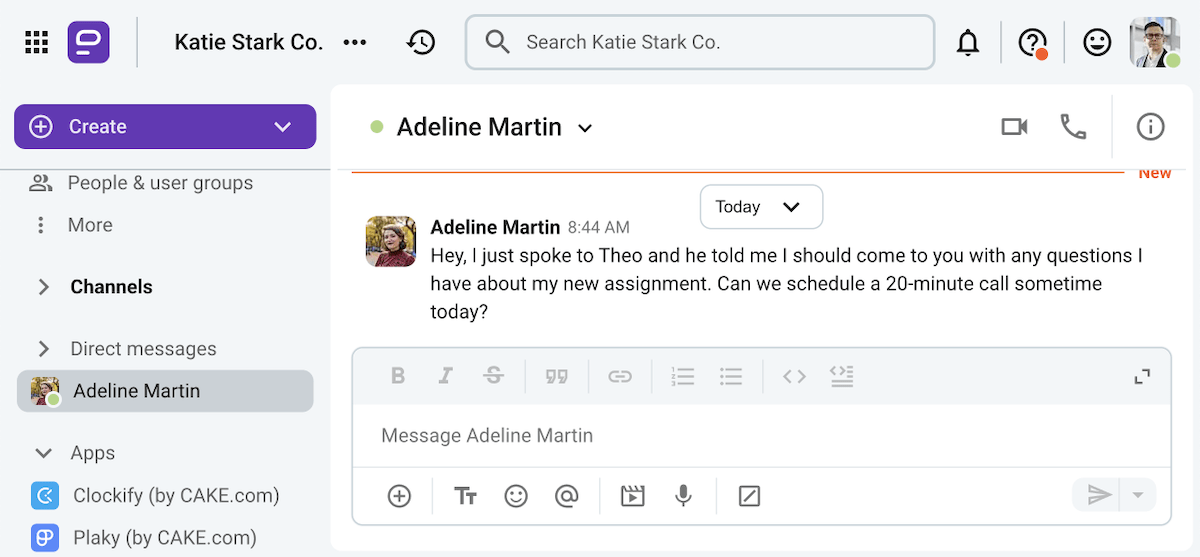
Tip #2: Be clear and concise
As we have established, active communication requires all participants to also be willing to actively listen.
However, that doesn’t mean that you should expect people to pay attention while you drone on about irrelevant details.
That’s when you risk crossing into the territory of overcommunication, which can overwhelm and exhaust your interlocutors.
But, according to Monica Rivera, a Personal Brand and Communications Strategist with 15 years of experience in marketing, learning how to express yourself concisely (or precisely) is the best way to avoid that:

“People mistakenly believe that active communication means saying more or speaking louder, but I teach that it comes from precision, being intentional with:
- Why we’re communicating,
- What we’re saying, and
- How it supports shared goals.
When communication lacks precision, meetings spiral, messages get misinterpreted, collaboration suffers, and trust erodes.”
So, if you want to improve active communication in the workplace, focus on making your messages as clear and concise as possible by avoiding tangents and digressions.
Of course, exercising appropriate self-disclosure by telling anecdotes that are relevant to the discussion can have its place in the process of active communication.
But, at the end of the day, it’s all about expressing yourself with intent and precision.
💡 PUMBLE PRO TIP
The clarity that can be achieved through active communication is particularly useful for avoiding confusion in instances of crisis and change communications. For more information on that, check out the following guides:
Deliver your executive communications through Pumble
Tip #3: Keep your body language in check
Whether you choose to express yourself verbally or in writing, chances are, you’ll need to supplement your message with nonverbal cues and visual communication tools as well.
If you’re communicating your message in written form, you should pay special attention to phrasing and emoji use, which serve as subtextual indicators of tone and intent.
However, even in instances of in-person interpersonal communication, you should make sure your body language matches the message you’re trying to convey.
In other words, you should keep your nonverbal cues in check by:
- Controlling your vocal tone and inflection,
- Not fidgeting or moving your arms too much,
- Having an open but relaxed posture, and
- Maintaining eye contact naturally.

💡 PUMBLE PRO TIP
Did you know that some nonverbal cues are culturally determined? If you work in a multicultural environment, check out our guide on cross-cultural communication:
Tip #4: Know your audience
When engaging in any type of organizational communication, your outcomes are sure to benefit from being aware of who the recipient of your message will be.
So, before you even start communicating, you should consider your audience in terms of:
- How much they already know about the subject or situation you want to discuss,
- What kind of beliefs and opinions they have about you or the subject at hand, and
- Whether they’re a peer, a higher-up, or perhaps an external collaborator.
Knowing these things will help you tailor everything, from the content of your message to the manner in which you’ll deliver it.
Of course, that doesn’t mean that sticking to outdated rules of formal communication guarantees successful outcomes.
After all, conveying warmth is still a big part of active communication, especially in the digital age, as Lucy Owen, a Director of People, told us:

“In a digital world, tone can get lost, so we stress clarity and warmth in written messages. Emojis aren’t unprofessional if they humanise a message.”
Tip #5: Invite questions
As you wrap up your message, there are a few ways to ensure clarity and understanding.
One of them includes inviting questions by saying something like:
- “So, what do you think about all of this?”
- “Let me know if I need to explain any of this in further detail.”
- “If you think of any questions after this meeting, feel free to contact me.”
In asking these questions, you are making it clear that being understood is your ultimate goal and that you wouldn’t mind going back and explaining certain points to make sure you achieve that understanding.
This is particularly important when you’re engaging in downward communication with your team, as employees tend to be somewhat hesitant to ask clarifying questions of their superiors. If nothing else, knowing that employees may not want to get in touch after your initial exchange should motivate you to make your message as clear as possible from the get-go.
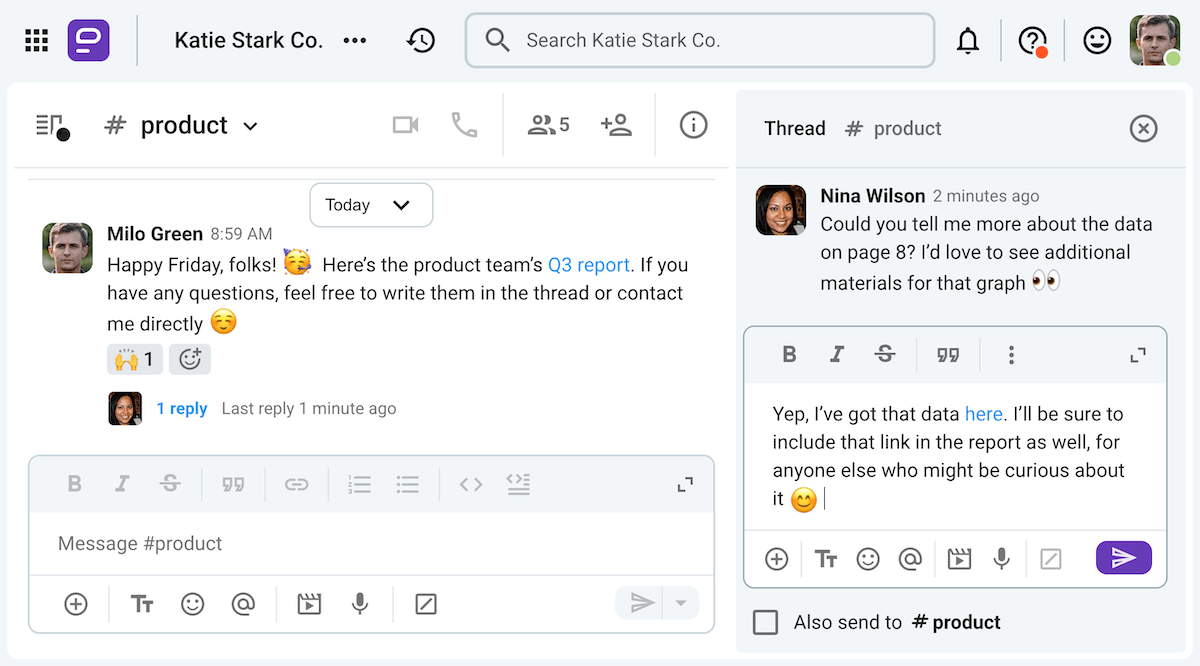
Organize your conversations with Pumble threads
Tip #6: Provide next steps
If your message isn’t just informative, chances are, you won’t need to cap it off by inviting questions.
Instead, you should finish the conversation in a way that clearly outlines the next steps you’d like the other person to take.
For example, you might want them to:
- Take on an additional assignment,
- Contact someone for more information, or
- Deliver a status report about their ongoing tasks.
In any case, your conversation should end with everyone knowing exactly what’s expected of them and what their next steps should be.
Ultimately, the practice of active communication in the workplace requires you to go into conversations with your desired outcome in mind, as noted by the Leadership Coach, Dana Zellers:

“Before you speak, ask yourself: ‘What do I want them to think, feel, or do after this conversation?’ Once you know the answer, you can tailor your message to create that result.”
Part 2: The skill of active listening (thoughtful decoding)
As we have established, active communication consists of 3 (often simultaneously occurring) processes.
We’ve already discussed the first one, so let’s talk about the second one: the process of active listening.
If you want to sharpen your effective communication skills by becoming a better listener, you should:
- Listen to understand, not to reply,
- Pay attention to nonverbal cues,
- Avoid interrupting, and
- Paraphrase to confirm understanding.
Here’s how you can do just that.
Tip #1: Listen to understand, not to reply
Whether we’re engaging in a bit of small talk at work or more formal corporate communication, our desire to keep the conversation going can often tempt us to prepare responses to what we hear even as we hear it.
And, though some of those responses can be a sign of engagement and active listening — such as the occasional hum and “I hear you” — more self-centered replies can be pretty disruptive to the other person.
Ultimately, focusing on your own responses when someone is speaking can make it difficult to understand or even hear what’s being said, as Dana Zellers told us:

“Active listening starts with giving others space to fully express themselves before you respond. Before offering your own point of view, make sure you understand not only what’s being said but what’s behind it.”
So, try to go into conversations in the right state of mind, open to understanding the other person’s point of view.
Hear what your coworkers have to say on Pumble
Tip #2: Pay attention to non-verbal cues
You might have heard that 93% of communication is nonverbal.
But, though that stat is a misinterpretation of research that’s evolved into one of the most enduring communication myths, it’s true that the importance of nonverbal communication can’t be overstated.
Nonverbal cues can tell you a lot about how your interlocutors are feeling at any given moment — allowing you to gain greater insight into their moods and opinions.
Of course, in the age of team communication apps, we may not always have the option of seeing our interlocutors in person. That’s why having video calls can be so helpful, according to marketing expert Peter Lewis:

“Rule one: cameras on during key calls. You can’t actively listen if you’re not visibly present. It builds connection and minimizes multitasking.”
As Lewis states, having cameras on also allows you to show that you’re actually interested in what the other person is saying.
However, in textual communication, showing that you’re hearing what the other person is saying can be somewhat tricky.
On top of that, being able to tell how the other person is feeling based on their texting style alone also requires you to have preexisting knowledge of their texting preferences.
That should allow you to read the subtextual elements of the message, such as tone, sentence structure, emoji usage, etc. Here’s an example of how these elements can clearly indicate how a person is feeling.
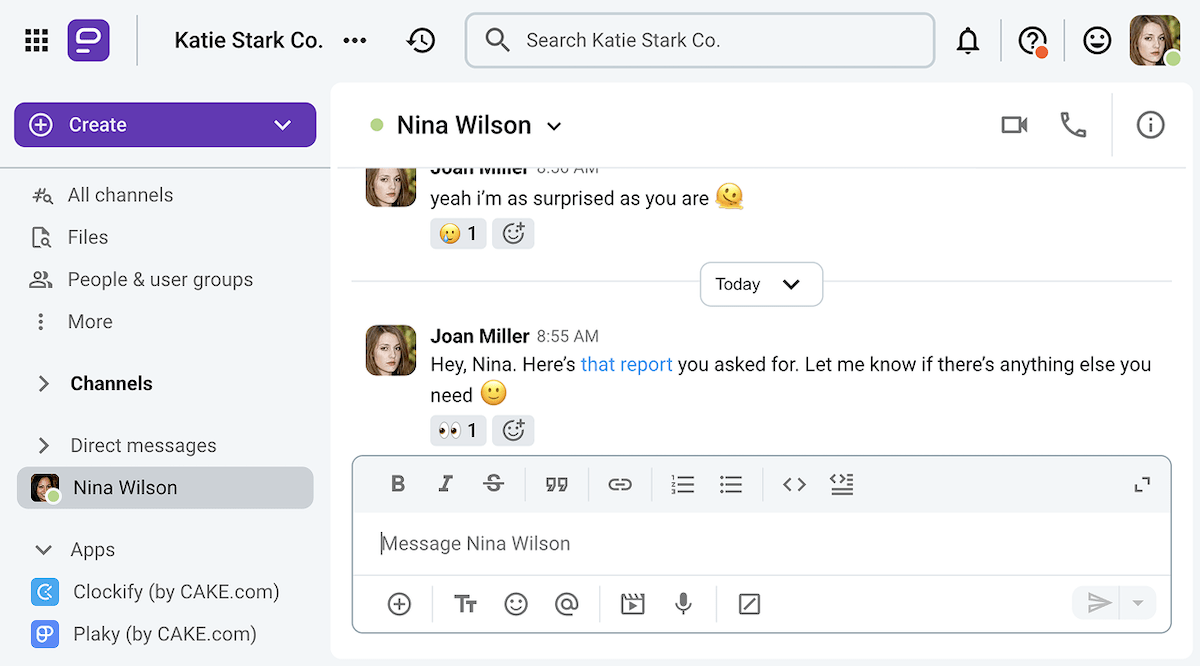
Use emojis to respond to messages and in video calls on Pumble
Tip #3: Avoid interrupting
If you really want to show that you’re interested in what someone else is saying, start by giving them the time and space they need to get everything off their chest.
In other words, you need to create a sense of psychological safety in the workplace, as Lucy Owen explains:

“Active listening starts with creating safety. People need to feel they won’t be judged, interrupted, or dismissed.”
In a group communication setting, making sure no one is cutting into someone else’s time to speak can be somewhat difficult. Still, if you’re a manager, you could just have your team members take turns to speak.
Even as a regular employee, you can encourage this type of courtesy and positive communication by bringing the conversation back around to team members who may not have gotten their chance to finish speaking.
💡 PUMBLE PRO TIP
Being patient is always a virtue, but especially when you know you’ll be discussing sensitive topics. But, if you’re not quite sure about how to broach those kinds of topics with your employees, this guide should help:
Tip #4: Paraphrase to confirm understanding
As we know, the point of practicing active communication in the workplace is to ensure mutual understanding.
As a listener, the best way to do that would be to paraphrase what the other person said to make sure you understood the gist of their message.
This can be paired with other behaviors that are often used as indicators of active listening, as a communication coach and speech and language pathologist, Allison Geller, told us:

“A great listener shows engagement through small behaviors like:
- Nodding,
- Paraphrasing what was said, and
- Asking clarifying questions.
Leaders, in particular, can model this by saying, ‘What I hear you saying is X, is that correct?’ This reduces misunderstandings and makes employees feel respected and heard.”
In addition to helping you avoid various communication challenges, paraphrasing can also be used to ensure accountability, as an HR consultant with 25 years of industry experience, Shelley Majors, noted:

“For listening, managers should model curiosity. Ask follow-up questions and repeat key points to confirm what was heard. It builds confidence and accountability on both sides.”
Here’s an example of what this might look like in a written exchange.
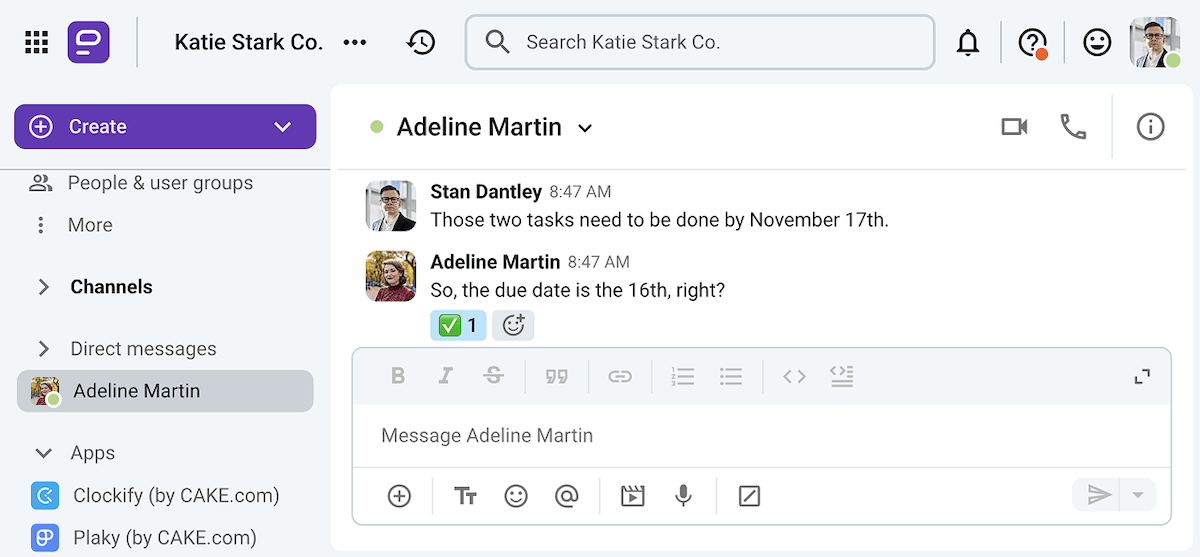
Keep all communication on the record with Pumble
Part 3: The power of closing the loop (feedback & clarification)
Finally, it’s time to talk about the third stage of active communication in the workplace — feedback and clarification.
This stage ensures that everyone has said their piece and been acknowledged by all relevant parties.
Now, since the process of active communication is ultimately a two-way street, participants will usually act as both encoders and decoders of messages.
With that in mind, they should be actively:
- Seeking feedback to make sure their message is being properly processed,
- Providing ongoing feedback to indicate interest (by paraphrasing the speaker’s statements and encouraging them through nonverbal cues),
- Asking open-ended questions to clarify certain points, and
- Delivering follow-up information as necessary.
These actions help us close the active communication loop and make sure our interactions are successful and productive.
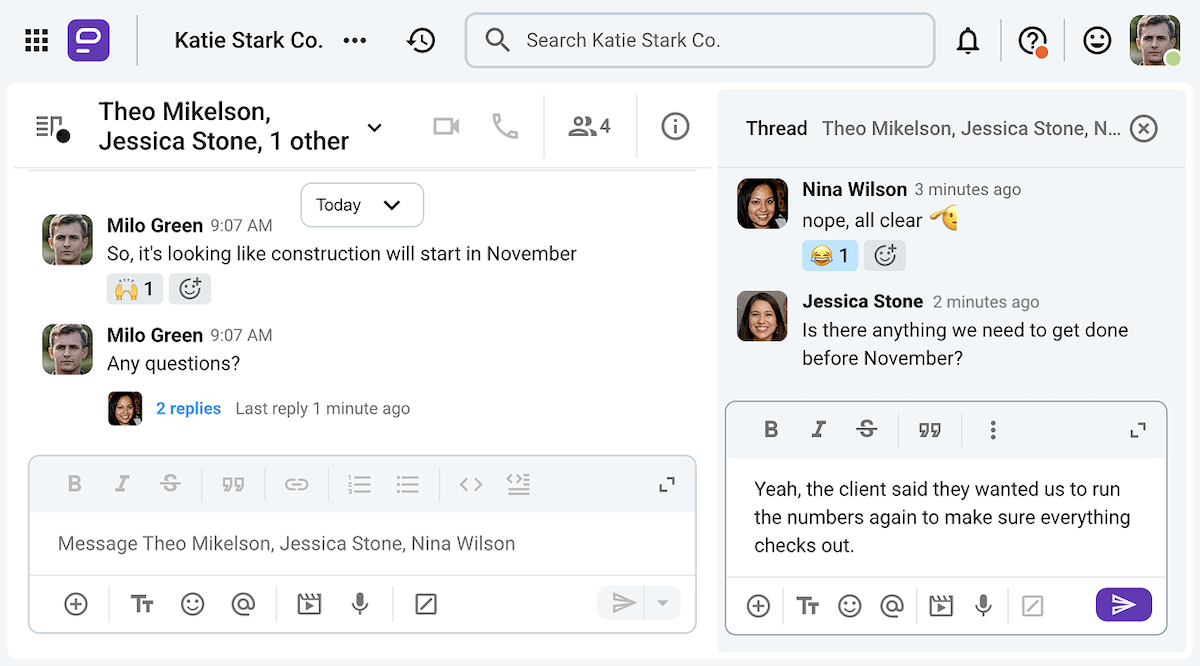
💡 PUMBLE PRO TIP
Feedback shouldn’t just comment on past actions and outcomes — it also needs to influence future ones. To see how you can change your team’s mindset around feedback, check out this article:
Introduce active communication to your team with Pumble
Finding opportunities to practice active communication in the workplace can be a daunting task, especially when our coworkers aren’t willing to be as involved in the process as we need them to be.
Still, there are ways to model active communication and active listening to the people we work with — even in the era of instant messaging apps.
Here’s how you can use an app like Pumble to enhance every step of the active communication process:
- Use visual aids like screen sharing in video messages or on video calls to illustrate your points,
- Paint a more complete picture by sending relevant files and images to channels or in DMs,
- Take the time to read and process messages before responding, thanks to the asynchronous nature of communication through Pumble,
- Acknowledge messages by using emoji reactions, and
- Close the loop and keep your feedback relevant by responding in threads.
So, take charge of your communication outcomes with Pumble.
Create a digital practice ground for active communication.





